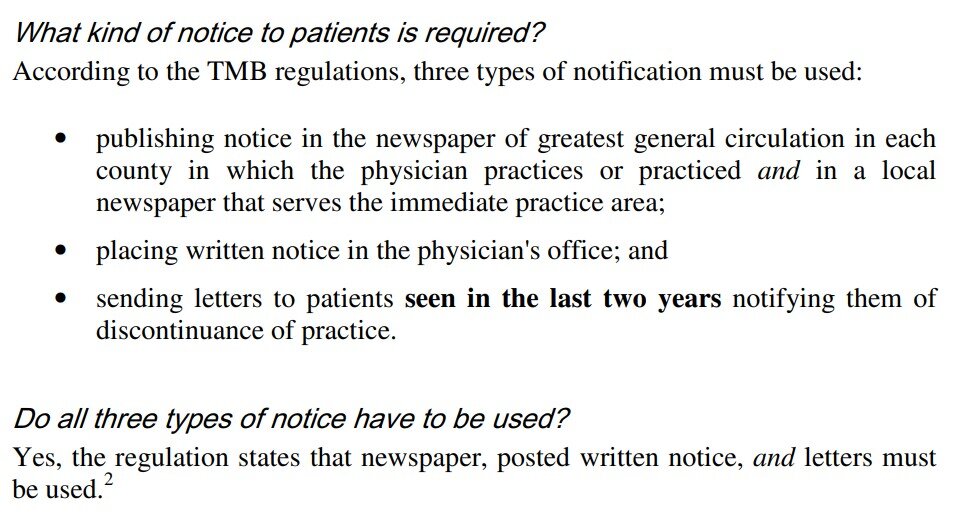

70% of doctors across all specialties change jobs within their first two years.
Although being a doctor is one of the most prestigious career paths, it’s still a job. In other words, it shouldn’t be that big of a surprise that doctors move to different healthcare facilities. They may get a new job somewhere else for the same reasons that another professional did.
Maybe the doctor…
The list of reasons why a doctor would leave his/her practice isn’t finite. There are hundreds of reasons why it could happen.
Another important statistic to keep in mind is that almost 20% of doctors have considered leaving their practice.
In other words, healthcare organizations aren’t immune from experiencing turnover. But walking away from your current place of work as a physician isn’t as easy as it might be in other industries.
If you were a sales professional and you had a better opportunity lined up, your leaving process would look like this…

In the business world, the resignation process is quick and painless. In fact, it’s not uncommon for organizations to expedite the last day for their employees who are moving on. That last statement is especially true for those in the sales profession.
I haven’t even mentioned that resignation might not be specific to the job. You might just be ready for retirement.
Anyway, of course, leaving your practice as a physician is more complicated than in other industries. It’s a more sensitive and highly personal industry, patients share their most intimate details with and confide in their physicians. This is also why it’s one of the most highly regulated industries in the world (i.e. HIPAA ).
What I’m trying to say is that doctors can’t just announce that they’re leaving their practice, make a few phone calls to their favorite patients and leave. There’s a little more nuance to it, some of which involves the law.
Out of everything you’d need to do, though, the most important aspect is to notify your patients of the physician leaving your practice. Maybe you’re the physician, or maybe you’re the practice manager. Either way, it needs to happen. Here are some examples of effective letters for your consideration.
I hinted at this section in the introduction of this blog post. In other words, this shouldn’t be that big of a surprise to you.
There are certain legal “hoops” physicians and their practices need to take before allowing a departure.
Luckily, your state's medical board should be able to provide you some guidance as to what you’re required to do before you leave the current practice that you work at.

The Texas Medical Board (TMB) provides a great resource that explains what physicians need to do before leaving their practice. More specifically, it points out that it’s the physician’s job to ensure that their patients…
The next logical question most Texas physicians would have after reading their responsibilities upon leaving is, “What are the requirements on the type of notification?”
Of course, TMB has that covered. I did say that this board provides a helpful resource.

According to TMB, it’s required for physicians who are leaving their practice to publish their notification of leaving in three ways…
The requirements for patient notification upon leaving differs for every state. Thus, you should check your medical board to see if they have a resource for you to reference. Regardless of whether or not they do or don’t, though, it’s also still a good idea to consult with a legal representative prior to making your announcement public.
After reading the requirements for notification in the previous section, your immediate reaction probably filled you with anxiety.
How do you even begin to notify newspapers? You most likely aren’t an experienced public relations professional, so you likely don’t have a Rolodex full of media contacts to go through.
However, it’s the 21st century and you have the tools at the palm of your hands to get in contact with media outlets, you just don’t know it yet.
There are plenty of affordable press release services out there that you can utilize to satisfy any of your state’s media requirements.
Of course, then you’re most likely wondering where to even begin with your press release.

The first example letter for notifying patients of a physician leaving their practice comes from Medical Center Clinic.
You’ll quickly notice that it’s actually not a letter that talks about a physician leaving, rather it’s a new doctor welcome letter. Don’t worry, I did that on purpose.
This example is conceptual.
Take a look at the different elements that the Medical Center Clinic added to its new doctor announcement. The press release has…
Each of those elements is the industry standard when it comes to press release creation.
In other words, you should use this new doctor announcement press release as a template for creating your notification of leaving. Its format is superb while helping you satisfy media notification requirements.
I’m going to continue to refer to the requirements laid out by the TMB throughout the rest of this blog post to help you satisfy its requirements. If your practice isn’t located in Texas, it’s likely that your state has similar stipulations in place.
Even if it doesn’t, I would consider everything that TMB laid out as a best practice when it comes to notifying patients of a physician leaving.
Anyway, the next great example letter comes from Palos Health.

Yes, I know this example is an image of a letter taken from a smartphone’s camera. That’s actually what makes it so great.
The image comes from a Palos Health patient, who received the notification that their doctor is leaving through the mail.
That last part is the key to this entire section. Mailing the notification letter to your patients satisfies another requirement laid out in TMB’s resource.
Although some patients may view mail as an archaic form of communication. It’s still one of the most secure ways for healthcare organizations to keep in contact with their clients (Hopefully, you have your patient’s right address on file). Of course, you can send your patients notifications via email if they prefer. But, why not both?
Anyway, the formal letter from Palos Health states that the doctor that the patient used to see no longer works there. It also provides contact information and explains that transferring medical records is available upon request. Both of those satisfy requirements laid out by TMB.
One of the best ways to navigate the sensitive scenario where a physician leaves a practice is by having the doctor write a personal memo.
A memo provides a great opportunity for the physician who’s leaving to reminisce about their experiences with the practice and provide personal anecdotes. Of course, they won’t be able to go into great detail in their stories, they won’t want to deal with a HIPAA violation on their way out.
Yet, it’s a nice touch that will (hopefully) make the announcement a little easier to deal with from their patients’ perspectives.

The third great example does exactly that. It also gets bonus points for creating it in a digital format.
Kimberley Forthofer, ARNP wrote a personal memo that announced her resignation from Palouse Medical in June of 2013. At the time of writing, I can’t imagine she thought that she would end up in a blog post almost a decade later.
Anyway, she did a great job being upfront about the situation in saying that she’s leaving to return home to Montana. It’s a very personal scenario, but her opening up makes her leaving much more digestible from a patient perspective.
Palouse Medical gets bonus points for designing her notification in a digital format because it could be easily shared across different social media platforms.
Sharing the notification on social media isn’t a spelled out requirement from TMB’s perspective, yet it’s another channel you should utilize. The odds that your practice utilizes at least one social media platform is pretty high, why not use it to your advantage?
This example is a little bit different than the others I’ve provided thus far. It isn’t flashy or in a fancy format. However, its beauty lies within its content.

This example comes from Veronica Munera, MD, who worked at Safecare Medical Center at the time. Like the example from Kimberley Forthofer, ARNP, she provides personal anecdotes throughout, but she also goes above and beyond.
Dr. Veronica provides references and praise to two other doctors that worked at Safecare Medical Center at the time of writing. This is a great idea because it helps make her patients feel even more at ease with her leaving.
Instead of her patients having to scramble to find a new physician, they can simply pick one based on their doctor’s own recommendation.
Doctors don’t always stay at the practice they first started practicing medicine under. Although prestigious and highly regulated, being a doctor is a career.
In other words, it’s not fair to expect your doctor to not have a life outside of their profession. Maybe where they’re currently practicing is far from where they consider “home”. Or, maybe they just don’t mesh with their current organization’s culture.
Regardless of the reason, they’re allowed to switch where they work.
Of course, they can’t just leave you “high-and-dry”. There are requirements that physicians who are leaving need to satisfy before their departure.
Once they satisfy those requirements, it's up to the patient to find a replacement physician.